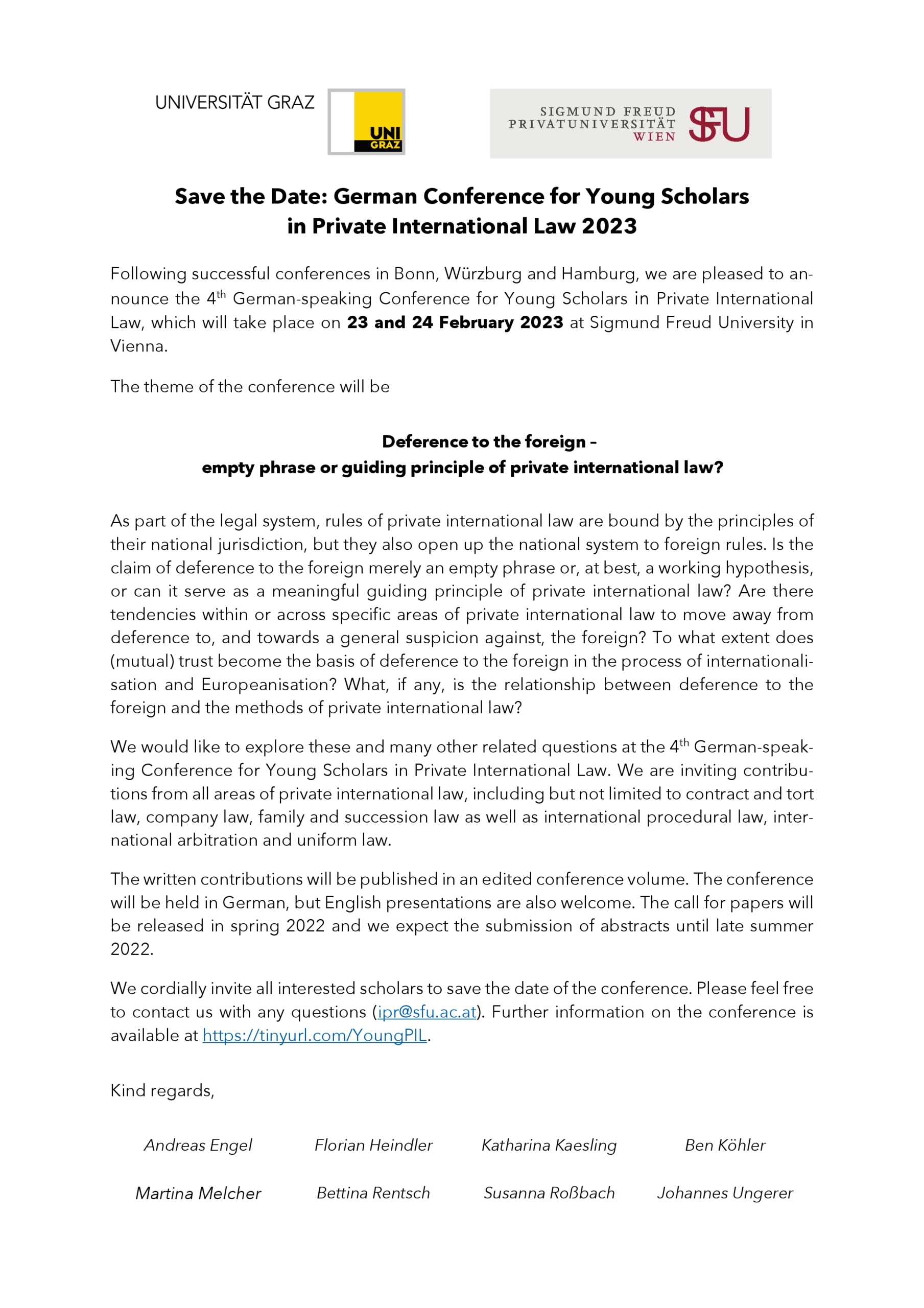Views
Nothing Found
Sorry, no posts matched your criteria
News
Call for Papers: SLS Conflict of Laws Section, Oxford Brookes, 2023
The convenors of the SLS Conflict of Laws section, Lauren Clayton-Helm and Bobby Lindsay, have been so kind as to share the following call for papers with us.
 This is a call for papers and panels for the Conflict of Laws section of the 2023 Society of Legal Scholars’ Annual Conference to be held at Oxford Brookes, from 27th – 30th June. The Conflict of Laws section will meet in the second half of the conference on 29–30 June and will have four sessions, each lasting 90 minutes.
This is a call for papers and panels for the Conflict of Laws section of the 2023 Society of Legal Scholars’ Annual Conference to be held at Oxford Brookes, from 27th – 30th June. The Conflict of Laws section will meet in the second half of the conference on 29–30 June and will have four sessions, each lasting 90 minutes.
Registration open: German Conference for Young Scholars in Private International Law 2023
As previously announced, the 4th German Conference for Young Scholars in Private International Law will take place on 23 and 24 February 2023 at Sigmund Freud University in Vienna.
The theme of the conference is
Deference to the foreign – empty phrase or guiding principle of private international law?
Although primarily held in German, a significant amount of presentations will be offered in English, including
“The metaphor of the ‘dismal swamp’: an ecosophical approach to the conflict of laws” by Prof. Horatia Muir Wat (Keynote lecture)
“Overriding Mandatory Rules and Choice of Law Rule in Procedure: Opposite Trends?” by Shahar Giller (presentation)
“Mind the Gap – Adaptation Mechanisms in the Cross-Border Enforcement of Judgments” by Tess Bens (presentation)
“Connecting Factors: Tools or Loopholes in Achieving Deference to the Foreign” by Stefano Dominelli and Michael Cremer (short presentation)
For further information and registration, please visit the event’s homepage – the organizers kindly ask to register by 17 February 2023.
Chronology of Practice: Chinese Practice in Private International Law in 2021
Professor HE Qisheng has published the annual report, Chronology of Practice: Chinese Practice in Private International Law in 2021, now in its 9th year. The article has been published by the Chinese Journal of International Law, a journal published by Oxford University Press..
This survey contains materials reflecting the Chinese practice of Chinese private international law in 2021. Firstly, regarding changes in the statutory framework of private international law in China, six legislative acts, one administrative regulation on Counteracting Unjustified Extra-Territorial Application of Foreign Legislation and Other Measures, and six judicial interpretations of the Supreme People’s Court (“SPC”) were adopted or amended in 2021, covering a wide range of matters, including punitive damages, online litigation, online mediation, and international civil procedure. Secondly, five typical cases on Chinese courts’ jurisdiction are selected to highlight the development of Chinese judicial practice in respect of consumer contracts, abuse of dominant market position, repeated actions and other matters. Thirdly, this survey considers 18 cases on choice-of-law issues relating, in particular, to capacities of legal persons, proprietary rights, employee contracts, mandatory rules, gambling and public policy. Fourthly, two significant decisions on punitive damages of intellectual property are reported. Fifthly, several key decisions in the recognition and enforcement of foreign judgments, international arbitration agreements and foreign settlement agreements, are reproduced. Lastly, this survey also covers the Summaries of the National Symposium on Foreign-related Commercial and Maritime Trials of Courts published by the SPC, an official document which represents the current judicial practices in the Chinese courts, and which is expected to provide guidance in the adjudication of foreign-related matters in the future.
Table of Contents
- Introduction
- Overview
II.A. Report on the Work of the SPC in 2021
II.B. Laws and the SPC’s interpretations
III. Jurisdiction
III.A. Rules in the SPC Summaries on Foreign-related Trials
III.B. Consumer contract
III.C. Different courts agreed upon in the principal and accessory contract
III.D. Jurisdiction over abuse of dominant market position
III.E. Repeated actions
- Choice of law
IV.A. Rules in the SPC Summaries on Foreign-related Trials
IV.B. Capacity of legal person
IV.C. Rights in rem
IV.D. Obligations
IV.E. Mandatory rules
IV.E.i. Foreign exchange guarantee
IV.E.ii. Share transfer
IV.F. Gambling and public order
- Intellectual property
V.A. New rules on punitive damages
V.B. Selected cases on punitive damages in Chinese courts
- Foreign judgments
VI.A. Rules in the SPC Summaries on Foreign-related Trials
VI.B. Cases about recognition and enforcement of foreign judgments
VII. International arbitration and foreign awards
VII.A. Rules in the SPC Summaries on Foreign-related Trials
VII.B. Arbitration clause and a lien dispute over the subject matter
VIII. Confirmation of the validity of foreign settlement agreement
Here are the links to the article:
- Standard link:
https://academic.oup.com/chinesejil/advance-article-abstract/doi/10.1093/chinesejil/jmac041/6988730?utm_source=advanceaccess&utm_campaign=chinesejil&utm_medium=email - Free-access link:
https://academic.oup.com/chinesejil/advance-article/doi/10.1093/chinesejil/jmac041/6988730?utm_source=authortollfreelink&utm_campaign=chinesejil&utm_medium=email&guestAccessKey=01d9c811-e555-4366-8b93-3259516005d8



